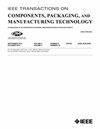Highly Manufacturable Packaging of an Implantable Episcleral Surface Stimulator With Reliability and Safety Validations
IF 2.3
3区 工程技术
Q2 ENGINEERING, ELECTRICAL & ELECTRONIC
IEEE Transactions on Components, Packaging and Manufacturing Technology
Pub Date : 2025-01-20
DOI:10.1109/TCPMT.2025.3531795
引用次数: 0
Abstract
This study presents an innovative packaging scheme for an implantable medical device (IMD) which is an episcleral surface stimulator applying trans-scleral electrical stimulation. The stimulator employs an application-specific integrated circuit (ASIC) to facilitate wireless connection and electrical stimulation. The proposed packaging scheme considers the safety, functionality, reliability, and particularly manufacturability of the stimulator. The packaging process is structured into chip-level, component-level, and device-level. At the initial chip-level packaging, a silicon interposer is introduced to enhance the manufacturability and increase the bonding strength. At the component-level packaging, a flexible printed circuit (FPC) integrates all the components to enable the electrical functions. The FPC is curved by the bending method. The specialized design of the stack and layout addresses the biocompatibility concern. Finally, the device-level packaging incorporates Parylene-C coating and silicone encapsulation to form the final stimulator. At this packaging stage, a novel strategy is introduced eliminating the challenging Parylene-C etching process while streamlining the bending and the silicone encapsulation processes. The outstanding manufacturability achieved from the proposed packaging scheme allows consistent product quality, leading to trustable reliability validation. The reliability of the stimulator is approved by a high-temperature saline soaking test which indicates a minimum 6.1-year lifespan. Additionally, trial surgeries on a rabbit validate the shape and softness, and the biocompatibility of the stimulator is also confirmed by implantation tests on mice.求助全文
约1分钟内获得全文
求助全文
来源期刊

IEEE Transactions on Components, Packaging and Manufacturing Technology
ENGINEERING, MANUFACTURING-ENGINEERING, ELECTRICAL & ELECTRONIC
CiteScore
4.70
自引率
13.60%
发文量
203
审稿时长
3 months
期刊介绍:
IEEE Transactions on Components, Packaging, and Manufacturing Technology publishes research and application articles on modeling, design, building blocks, technical infrastructure, and analysis underpinning electronic, photonic and MEMS packaging, in addition to new developments in passive components, electrical contacts and connectors, thermal management, and device reliability; as well as the manufacture of electronics parts and assemblies, with broad coverage of design, factory modeling, assembly methods, quality, product robustness, and design-for-environment.
 求助内容:
求助内容: 应助结果提醒方式:
应助结果提醒方式:


